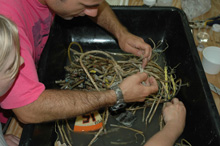Ten minutes after the Jason remotely operated vehicle (ROV) is back on deck, scientists examine tubeworms obtained with the "Bushmaster Jr.," a collection net. Click image for larger view and image credit.
After documenting the ecology of the tubeworm communities, scientists are collaborating with NOAA educators by providing leftover tubes (such as those shown here) to teachers as educational aids to promote ocean literacy. Click image for larger view and image credit.
Here We Go Again . . .
June 12, 2007
Stéphane Hourdez
Station Biologique de Roscoff, France
28° 29.49 N
88° 52.73 W
During our cruise last year, we collected a number of new species, including a new species of tubeworm. You may remember that tubeworms are very strange animals: without a mouth, gut, or anus, they obtain all their nutrition from symbiotic bacteria that live in their bodies. We had seen one or two individuals of this species before, and it was one of our primary goals to collect more so the species could be formally described. Back when we collected the new species, we knew it belonged to the genus Lamellibrachia (based on its morphology), but we had to wait until we got back to our lab equipment on shore to find out much more.
Over the past year, we have carefully analyzed the individuals in our collections and confirmed that they were Lamellibrachia and belonged to a new species. We also obtained the DNA sequence of a gene that is often used to establish the relationships between species and has previously been used for this purpose in tubeworms. When we analyzed this sequence, it revealed that our deep Gulf of Mexico species was most closely related to Lamellibrachia luymesi, the tubeworm species on the upper slope of the Gulf of Mexico. This suggests that the deep-water circulation may have separated two populations that later diverged into two species. This finding helps us learn more about how seep species and communities are all related to each other throughout the Gulf of Mexico and the Atlantic.

Erik Cordes and Guy Telesnicki retrieve the Bushmaster Jr. tubeworm collection net from the ROV.
There was another unexpected finding in the DNA sequence data. One individual’s sequence clearly set it aside as a different species. It is most closely related to a species recently collected on mud volcanoes in the Mediterranean, and then more distantly related to the other Lamellibrachia species from the Gulf of Mexico. When we saw this, we were shocked. How could we have missed this during the cruise? We got together and started looking back at all of our notes. We usually take tissue samples for DNA from the first 10 or 20 individuals we measure on board. This one was labeled “Lamellibrachia #34.” During the cruise, we spotted that one individual as looking unusual so we took some extra samples. But this was just a hunch based on a single individual out of the hundreds we looked at, and we didn’t see anything really remarkable about it at the time. We will be sure to keep our eyes peeled to try to find more during the rest of this cruise.

































